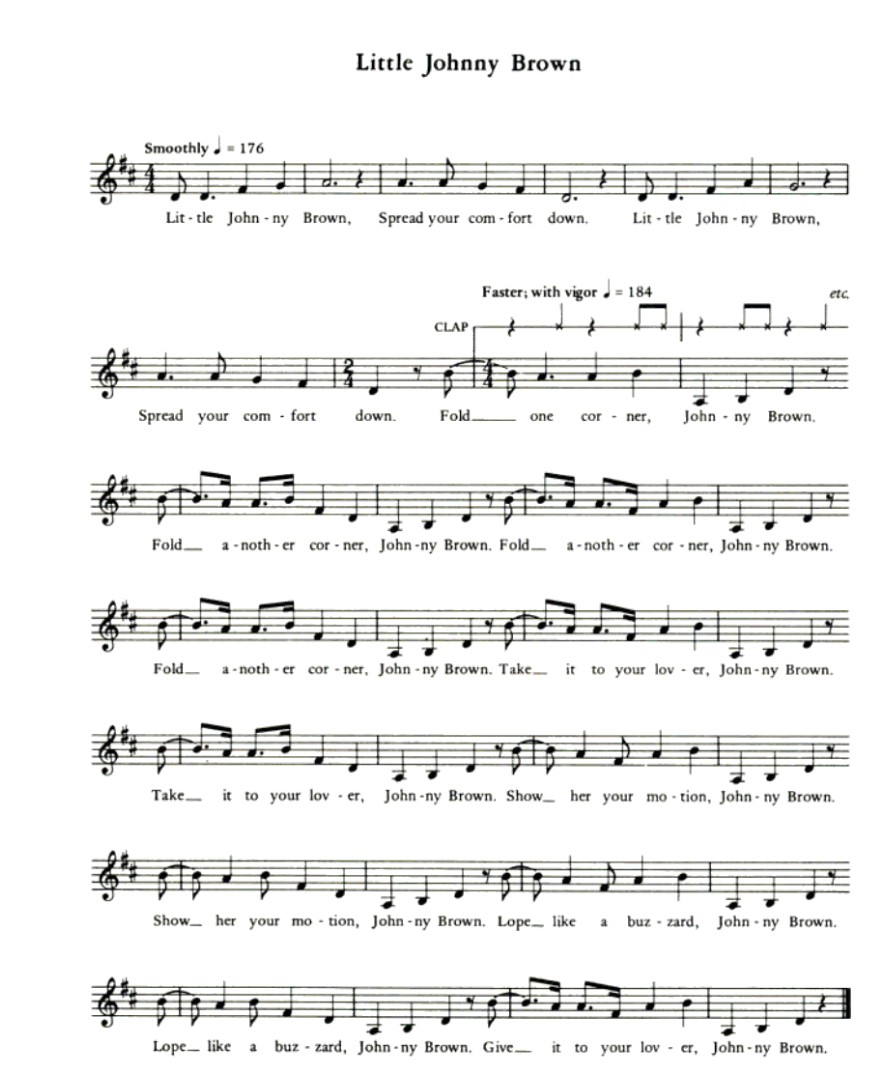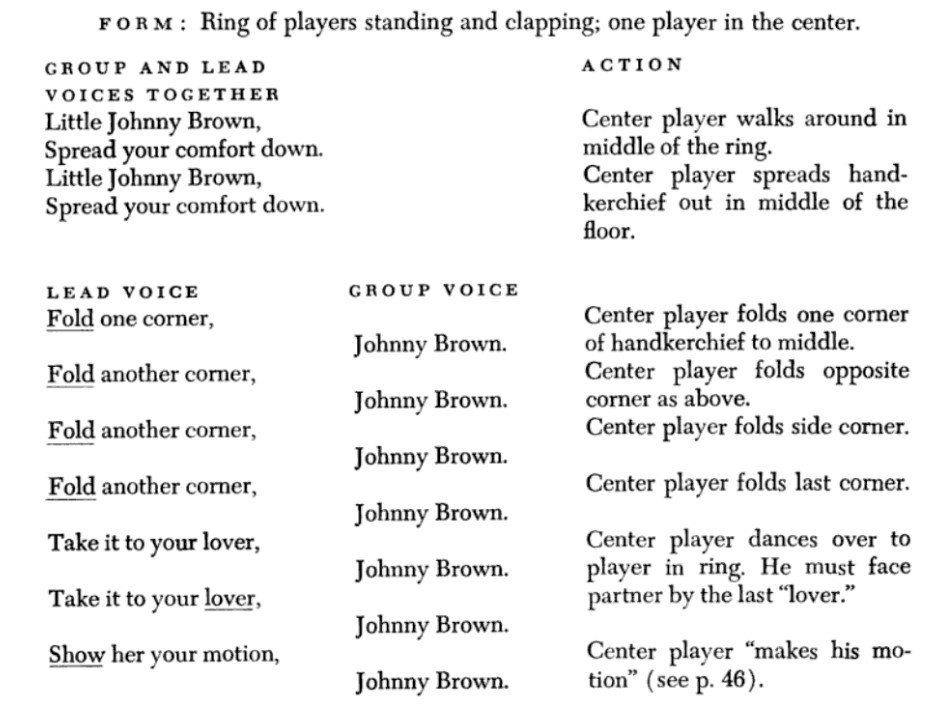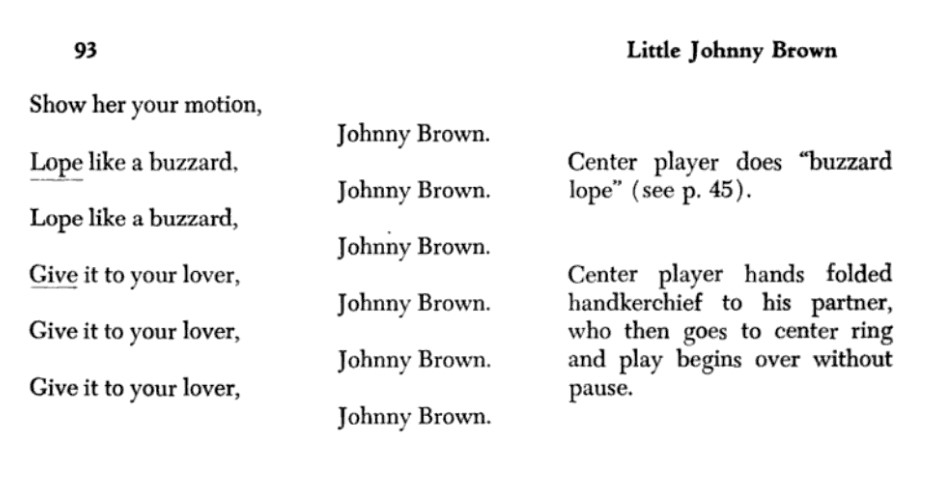Selections: Little Johnny Brown
Recorded: Central Park, New York City, NY (August 1965)
Performers: Bessie Jones (tambourine, vocal), John Davis (clapping/foot stomping, vocal), Peter Davis (clapping/foot stomping, vocal), Mable Hillery (clapping/foot stomping, vocal), Emma Ramsay (clapping/foot stomping, vocal)
Activity 1: Call & Response
- Prior to each listening of the recording, focus the students’ listening with the following questions (play approx. :30 seconds after each question):
- Questions: Does it sound like there is a leader of this song? What gives you that impression? (Answer: Yes. She is singing the entire song, while everyone else is just singing parts/responses of it. Other possible answers include: she is singing louder than the rest/she has a microphone and the others do not)
- Questions: Do you hear any instruments being played such as a guitar, piano, banjo, or anything? What do you hear besides singing? (Answer: No. We hear a tambourine, hand-clapping, and stomping)
- Question: Listen to the pitch of the melody every time she sings “Johnny Brown” in the second part of the song. Are all of the ‘Johnny Brown’s sung the same way? (Answer: No. The melody alternates between going up and returning to the tonic [l, l, d and l, d l,])
- Solo sing the song and prompt the students to sing all of the ‘Johnny Brown’s in the 2nd part of the song. (Note: it might be necessary to reinforce the alternating pitches by showing the melody on your fingers or a tone ladder).
- Discuss: “In music, when one person or group sings something, and another answers, we call this ‘Call & Response’.
- Sing the song again, this time using the new terminology to describe how the group will sing: “I’ll sing the call, and you sing the response.”
- Demonstrate the traditional game (as described in Bessie Jones’ Step it Down, and attached at the end of this lesson) without instruction. Prompt the students to continue singing the responses throughout the song.
- As you continue to play the game in step 4, encourage students to add body percussion, using the following entry points:
- Beginner: Stomp the beats
- Intermediate: Stomp the beats and clap the off-beats
- Advanced: Stomp the beats and improvise clapping/body percussion rhythms
- Once the students are comfortable performing the song and playing the game (after multiple classes), invite other children to become the “leader” that sings the “call” as a continuation activity.
Activity 2: Music of the Georgia Sea Islands
- Explain that this music comes from the Georgia Sea Islands, off the coast of Georgia. Using a map of the United States, have the students locate the state of Georgia. Explain that the Sea Islands are a chain of small islands right off the coast of Georgia. (*using an interactive map on a projected computer screen will allow the students to directly locate the islands).
- Explain that the Sea Islands are rich in African-American culture. Using a world map, textbooks, the Internet, or any other resources the students have at their disposal, encourage students to individually figure out what can explain the large African-American population in this part of the country. Students can share their findings in the next class. (Answers: Students will hopefully recall learning about slavery and the slave trade from their history class [many state curricula teach slavery and the Civil War during 4th grade]. They should be able to identify that many Africans were brought to the southern states of America before and during the 19th century, or will at least be able to identify slavery as a reason for the African-American diaspora).
- Discuss that in this area of the United States, there’s a particular group of people called the “Gullah people”. The song “Little Johnny Brown” is one of many songs from the Gullah people. Much of this music is based on play parties and singing games that is rooted in West African traditions. For example, the circle we make when we play is rooted in the dancing ring of West Africa.
- Question: “What kinds of things do we do when we sing in a circle like in Little Johnny Brown?” (Answers: one dancer in the center, improvising motion that others repeat, call and response singing, choosing a partner, etc.)
- Discuss: “Now that we know a little more about where this music comes from, let’s talk about the story of the song itself.
- Question: What do you think a ‘comfort’ is?” (Answer: A blanket.)
Suggest: When we lay our ‘comfort’ down, we’re laying a blanket on the floor. But we’re also doing more than that. We’re also putting our fears and our worries to rest. - Question: What is a buzzard? What do you think a buzzard lope is? (Answer: A buzzard is a bird. A buzzard lope is a kind of dance.)
Explain: A buzzard lope is a dance that that comes from West Africa and is seen in a lot of African-American music in the south. The dance was originally meant to depict a turkey buzzard circling its prey.
- Question: What do you think a ‘comfort’ is?” (Answer: A blanket.)



Additional Sources:
Jones, B., & Hawes, B.L. (1972). Step it down: Games, plays, songs, and stories from the Afro American heritage. University of Georgia Press.
Lesson plan designed by Will Coppola
